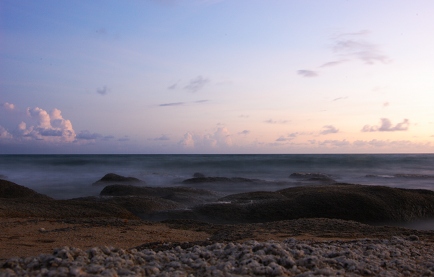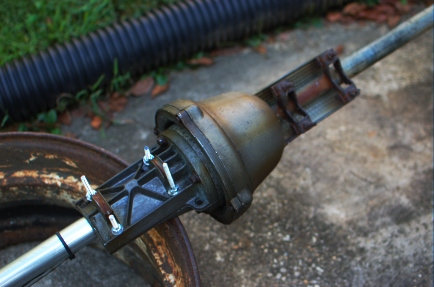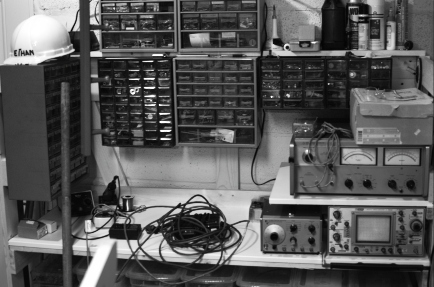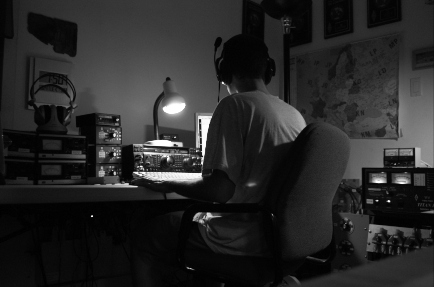I finally knocked a radio off my repair list. The TS-700S gave out during the ARRL January VHF Sweepstakes. It turns out that most of the problems were due to bad connections internally. I hit the heterodyne crystals and their sockets with contact cleaner and reflowed a few joints. I may yet fix the LNA, but with 10 watts, I haven’t had too much trouble being an aligator.
Archive for the ‘radio’ category
TS-700S repaired
February 16th, 2010Trials and Tribulations of a Geriatric Electronics Specialist
February 6th, 2010
I have an old radio problem. Make that three old radio problems…err…problem radios.
My first used radio was the TS-930S you see in this picture. It’s been good to me, and I’ve tried to reciprocate, although I am a contester. It hasn’t quite been the same since I put the third set of PA drivers in it and repaired the power supply. Something deeper must be wrong. I found out tonight that something deeper was indeed wrong, in the form of not one, but two, exploding electrolytic capacitors. At least I had one of them in the junk box, but I figured I was pushing my luck and came up here to the shack to blog instead of blowing up another one. The power supply pass transistors were assuredly toast since they were riding high at 40 volts—got that fixed. But, it still pops caps. Crap. Something is amiss in the final PA bias circuit (MRF-422). I don’t think that the ratings of the MRF-422’s have been exceeded. So, it should be a matter of diagnosing the bias circuit and getting back on track.
The TS-700S at right is my most recent used find. It’s in practically perfect cosmetic condition. But, during the ARRL January VHF Sweepstakes, the output power started fluctuating before finally going to zero. The T/R relay driver transistor failed, but there’s still something else going on—it looks like an ALC issue of some sort. I did just finally find a service manual for this guy and that should help the diagnosis. Although, the service manual is unusually vague about the purpose of some of the control signals that are passed between functional blocks. This might take a while, too.
The other TS-930 actually works, except only on 40 CW. On the other bands, the PLL unlocks. KA5IPF suggested that I tweak the master oscillator to keep it off the ragged edge of unlock. I’ve done that a few times and can’t quite hit the sweet spot. My next plan is to pull the PLL unit out (a real pain) and reflow all the solder joints on the board since it comes from the early era of the TS-930, when cold solder joints were common.
I’ve pulled the FT-840 out to be the second radio for bands other than 40 CW. And, I’m missing the Sprint tonight to spend time with my wife since I spent the better part of the afternoon tracing through the TS-700 and hooking up the FT-840. Fortunately, I have the FT-840 configured as a drop-in replacement for a TS-930—this is in no small part due to the fact that the PIEXX boards use Yaesu-style BCD band-decoders—so, I can plug right in with the appropriate adapter.
QSLing and other unfinished business
January 21st, 2010I’m making an effort to get unfinished projects finished around the hamshack and that means more QSLing and less blogging—this stuff makes for riveting reading, I know. Seriously, I really do enjoy exchanging the paper cards, even if the volume gets to me sometimes (and I shouldn’t complain—I’m not that active!). I’m actually nearly caught-up on direct QSLs, except the two difficult ones that USPS wouldn’t accept. And…drum roll, please…I’ve started whittling away at the BURO pile for the first time in four years.
As I was going through a stack of PJ2/K8GU requests tonight, I thought it would be interesting to plot the differences between the time I logged and the time the other station logged. For quick DX and contest contacts, this time should be the same. Some of them were really off, though! Sounds like another unfinished project to me…
More notes later on other projects…
Projects, projects, projects
December 11th, 2009There are lots of projects going on here at the ranch and I’m not sure where to start. So, I’ll make a dreaded bullet list. A lot of this stuff has been a long time coming and I haven’t even had to spend much money on it, just time.
QSLing:
- Some PJ2/K8GU cards are still in the queue since USPS didn’t like the “gift” (a laser-engraved poker chip) I was including with them—need to get padded envelopes.
- No KP4/K8GU cards have been replied to since I don’t have a card design yet. This will be a photo card.
- Plan to have all direct QSLing caught-up by the New Year.
HF station:
- QRV on 80/40/20 with full SO2R.
- Right TS-930S still needs a new set of MRF-485 drivers (although it puts out a few watts).
- Left TS-930S needs PLL/master-oscillator alignment so it will go to bands other than 40 meters.
- Built IK4AUY 2N5109 push-pull preamp from QEX article—needs finished and tested. Have enough parts to build two, but might go with the simpler W7IUV design for the other instead.
- Plan reduced-size K9AY for 80/40, maybe 160.
- Plan W3NQN RX filters to go on the K9AY ahead of the preamp.
VHF/UHF station:
- Wired in Jones plug(s) for the rotator.
- 50-MHz transverter project is stalled awaiting parts orders (SM caps and toroids).
- Do a planning cost analysis of 50- and 432-MHz transverter costs vs buying a used FT-817.
- Ordered W1GHZ 903- and 1296-MHz boards and kits with W8ISS.
- Plan PAs for 903- and 1296-MHz transverters.
Computers:
- Bought new keyboards and mice for sakhalin and formosa.
- Thanks to the generosity of a friend, sakhalin now has two Seagate Cheatah Ultra320 10-krpm 36-gB disks.
- Added the old 1.7-gB IDE disk from the “ham computer” to sakhalin so I can still run TR.
- Added the extra RS-232 ports from the “ham computer” to sakhalin for rig control.
- In the process of configuring sakhalin to triple-boot Windows 95 (aka MS-DOS 7 for contesting TR), Windows XP (so I have it), and Xubuntu.
- Plan to migrate formosa user data (not much of it) to sakhalin.
- Plan to convert formosa from Xubuntu to OpenBSD using 20-gB drive from sakhalin, plus 120-gB already inside.
- Plan to migrate crete server contents to formosa.
- Plan to convert crete back from Ubuntu Server to “ham portable computer” running Windows 95 (aka DOS 7).
- May run a network drop to the basement to use crete in the shop.
- The MacBook (vieques) still just works.
- So does the OpenWRT box (home).
And that’s just the hobby stuff! Well, most of it.
KP4/K8GU
November 17th, 2009
Sarah and I were in Puerto Rico for a few days on vacation. I made some contacts on 30, 17, and 10-meter CW. I had lots of trouble with my Bencher BY-2 paddles sticking in the humidity. I got it mostly fixed by removing one of the screws. But, it doesn’t change the fact that I felt like a real LID. I already had two QSL cards in the mailbox when I got home, though. Those will go out soon.
PJ2/K8GU QSL update
October 3rd, 2009Good news for those waiting for PJ2/K8GU QSLs: I finally went ahead and ordered the cards. Originally, I planned to do a full-color card as I had in my past operations. But, I just didn’t need 500-600 leftover PJ2/K8GU cards. So, I had some regular cards printed and they should be here in the next week or two. The direct cards will go out first. I thought about putting a unique QR code on each card so you could look up a nice write-up of the operation on the web plus verifying your QSO information. But, my wife the librarian tells me that’s poor preservation and that I’ll be a part of the “digital dark ages.” So, I’ve decided not to take that project on…
Rebuilding and installing the CDE TR-2
October 3rd, 2009
CDE TR-2
Back in March, I had the opportunity to pick up a TS-700S for the cost of shipping it from Arizona to Illinois. Since it’s an old radio with a built-in power supply, the shipping cost was significant, but $60 is a pretty good deal for a 2-meter all-mode radio. When we moved to Silver Spring, Maryland, I wanted to get on for the ARRL June VHF. I built a 6-element WA5VJB “Cheap Yagi” using a pine firring strip for the boom and 1/8-inch aluminum rod for the elements. I strapped this antenna to my DK9SQ mast with Ty-wraps and propped the radio up on moving boxes to make a few QSOs.
I stashed the antenna and radio until we visited my parents’ a few weeks ago. While I was home, I retrieved a CDE TR-2 rotor that had been at my grandparents’ vacation home in Lakeside, OH, until they had the roof replaced and I acquired their old TV tower. The TR-2 is the oldest of the CDE “bell rotors” and dates from the early to mid 1950’s. It’s a certifiable antique! I wired it up and plugged it in, only to discover that it was bound up. But, the motor hummed. So, I figured I had a chance. About a week ago, I pulled it apart (over a plastic bin to collect the ball bearings that fell out) and degreased the whole thing. I got the gears unbound and the shafts re-lubed and it worked like a charm. I greased the bearings and put it back together. Altogether, this was about an hour’s work—not too bad. They don’t make things like they used to, that’s for sure.
I was unable to find the exact U-bolts for the lower mast mount; so, I fabricated my own from some threaded rod. I put the rotor and antenna on a piece of fence top-rail and used ratcheting tie-downs to strap it to our chimney. There’s nothing quite like listening to a local beacon (W3APL/B) fade into the nulls of your beam. The multi-path is also pretty fascinating. I’ll have to do some analysis of that. Unfortunately, I haven’t been on the air for any tropo openings. So, I may have to wait until January to enjoy it.
When I was in middle school and high school I would have been delighted to come up with a working 2-meter SSB/CW station for less than $100. But, I suppose this is the advantage of time spent in the hobby. The longer you’re in, the cheaper some aspects of it get because you have time to be exposed to good deals… Anyhow, it sure was nice to do something dirty and mechanical after spending a lot of time in front of the computer at work. I’m working on a 6-meter transverter next.
The Workbench
September 11th, 2009
The Workbench
I finally got my workbench set up a the new place. Total cost: $10 (for an IKEA countertop from the AS-IS department—the only reason we go to IKEA) The workbench superstructure is recycled from the crate in which they moved our china cabinet. Now it’s time to sort through the junk box(es)! I’d like to pick up some more test equipment, but I’m (clearly) out of space for that at this time.
PJ2/K8GU (a long-delayed echo)
May 19th, 2009
PJ2/K8GU
So, those of you with whom I’ve spoken at length recently know this story and it’s a few months late. But, I found it on my computer tonight, even though I wrote it on the plane from CUR to MIA.
One of my first exciting memories of ham radio is sitting in the corner of my parents’ living room with a HeathKit SB-303 receiver borrowed from a family friend, Doran, N8ZYJ (SK, who was, coincidentally, the father of Dave, W9GR), listening to DX on 20 meter SSB. The first DX station I clearly remember hearing was PJ9JT and he had a tremendous signal. Fast forward fifteen years later: through my graduate research and the generosity of Geoff, W0CG/PJ2DX, I recently had the good fortune to spend a few hours at the latest incarnation of PJ9JT, the world-renowned PJ2T.
On the way from the airport, Geoff gives me the synopsis of the PJ9JT/PJ2T story: W1BIH visited Curacao and operated from a hotel on the northwest part of the island. The experience blew him away. He came back with some friends and they won a couple of contests with wires and a small tribander. Convinced that there was something special about the location, he built two houses right next to the hotel and set up PJ9JT in one of them. Geoff agrees that the place is special, to which I reply, “It’s the equatorial [ionization] anomaly.” “Exactly,” he says. Curacao is on the poleward edge of the northern crest of the anamolies, which are enhancements in electron density north and south of the geomagnetic equator.
Geoff adds, “We believe that more QSOs have been from the Signal Point QTH than any other single QTH in the world. This has certainly been the case over the past few years in which PJ2T has been the most-worked callsign in contesting.”
It’s easy to understand why. Geoff offers to let me play radio. “Well, if you don’t have anything else for me to do, sure.” He tells me it’s really important for shakedown since a group of guys is coming for WPX tomorrow—as
if I really need convincing. “Believe it or not, ” he tells me, “there are some hams who don’t want to operate the station when they visit.” What’s wrong with them?! I’m not the most proficient pile-up operator in the world; but, it was a good time. In about three and a half hours goofing around on 20, 40, and 80 meters CW, I added around 400 QSOs to that grand total…and, I don’t even know what I’m doing!
One of the great things about running a pile-up from the other end is understanding what makes callers easier to copy. The pile-up is a rumble of callers and you’re lucky to pull a few characters out of a call unless someone is loud or some of the other callers stop. Even a very weak off-frequency station bursts right through the other callers simply becuase (s)he is in the clear. After a while in my first stint of operating, Geoff passed me a note that he had a phone sked with W9JUV and K8ND in 10 minutes. I appreciated the relief from the cacophony of weak JAs. I had a nice chat with John and Jeff (sort of a fascinating story here; but, I’ll save that for later) after Geoff got up.
Later, I ask about the pile-ups. “Is it always like this, even during non-contest periods?” “Yes, ” he says, “you are so loud that they just call you. Back closer to solar max, we ran a multi-multi here and made 1000 QSOs the first hour. It’s unreal. The novelty of daily pileups wears off after a while. These days, I get a bigger kick out of keeping the station running.” Someone has to, that’s for sure. For it’s size, the station is a study in simplicity. Most of the coax routing is done with standard mechanical coax switches. There are only three (three more than Geoff would like, he tells me) rotators. But, with the salt air, corrosion is a continual problem.
Goose, W8AV, has been prodding me to join them for ARRL DX CW sometime. I’m definitely sold on it. It’s just a matter of time, permission, money, and AAdvantage miles now. Geoff said as he dropped me off at the airport in the morning, “You’re coming back for a contest now, right?” Right.
A note on PJ2/K8GU QSLs: I have received a handful of direct cards and my bureau sorter K8MFO always reminds me I’ll probably have a QSL rate of near 90%. I do plan to print cards this summer. But, I have to design them and buy them, yet. Thanks for your patience as I try to finish my degree and move! The first few cards will also receive a custom laser-engraved poker chip that I gave-out as favors during the work portion of this trip.
Dissection
May 11th, 2009
DBS Downconverter
I found an old satellite TV downconverter in the garage today. It drew me in and compelled me to disassemble it. One of the wonderful aspects of microwave circuits is that classical layout strategies persist. This board has a single layer of traces over a ground plane: everything is laid-out in one plane, quite visible and tangible (perfect for learning, I might add). The waveguide that feeds the antenna has two probes that bring the signal onto the board. You can see the I and Q channels and their respective LNA stages, the dielectric resonator oscillator in the center of the board, hairpin filters, mixers, bias lines and matching sections. Beautiful.